10 种聚类算法的完整 Python 操作示例

来源:海豚数据科学实验室 本文约7000字,建议阅读14分钟
本文将介绍一篇关于聚类的文章,10种聚类介绍和Python代码。
聚类是在输入数据的特征空间中查找自然组的无监督问题。 对于所有数据集,有许多不同的聚类算法和单一的最佳方法。 在 scikit-learn 机器学习库的 Python 中如何实现、适配和使用顶级聚类算法。
聚类 聚类算法 聚类算法示例
库安装 聚类数据集 亲和力传播 聚合聚类 BIRCH DBSCAN K-均值 Mini-Batch K-均值 Mean Shift OPTICS 光谱聚类 高斯混合模型
一. 聚类
聚类分析,即聚类,是一项无监督的机器学习任务。它包括自动发现数据中的自然分组。与监督学习(类似预测建模)不同,聚类算法只解释输入数据,并在特征空间中找到自然组或群集。
聚类技术适用于没有要预测的类,而是将实例划分为自然组的情况。 —源自:《数据挖掘页:实用机器学习工具和技术》2016年。
这些群集可能反映出在从中绘制实例的域中工作的某种机制,这种机制使某些实例彼此具有比它们与其余实例更强的相似性。 —源自:《数据挖掘页:实用机器学习工具和技术》2016年。
该进化树可以被认为是人工聚类分析的结果; 将正常数据与异常值或异常分开可能会被认为是聚类问题; 根据自然行为将集群分开是一个集群问题,称为市场细分。
聚类是一种无监督学习技术,因此很难评估任何给定方法的输出质量。 —源自:《机器学习页:概率观点》2012。
二. 聚类算法
有许多类型的聚类算法。许多算法在特征空间中的示例之间使用相似度或距离度量,以发现密集的观测区域。因此,在使用聚类算法之前,扩展数据通常是良好的实践。
聚类分析的所有目标的核心是被群集的各个对象之间的相似程度(或不同程度)的概念。聚类方法尝试根据提供给对象的相似性定义对对象进行分组。 —源自:《统计学习的要素:数据挖掘、推理和预测》,2016年
亲和力传播 聚合聚类 BIRCH DBSCAN K-均值 Mini-Batch K-均值 Mean Shift OPTICS 光谱聚类 高斯混合
三. 聚类算法示例
sudo pip install scikit-learn
# 检查 scikit-learn 版本import sklearnprint(sklearn.__version__)
0.22.1
# 综合分类数据集from numpy import wherefrom sklearn.datasets import make_classificationfrom matplotlib import pyplot# 定义数据集X, y = make_classification(n_samples=1000, n_features=2, n_informative=2, n_redundant=0, n_clusters_per_class=1, random_state=4)# 为每个类的样本创建散点图for class_value in range(2):# 获取此类的示例的行索引row_ix = where(y == class_value)# 创建这些样本的散布pyplot.scatter(X[row_ix, 0], X[row_ix, 1])# 绘制散点图pyplot.show()
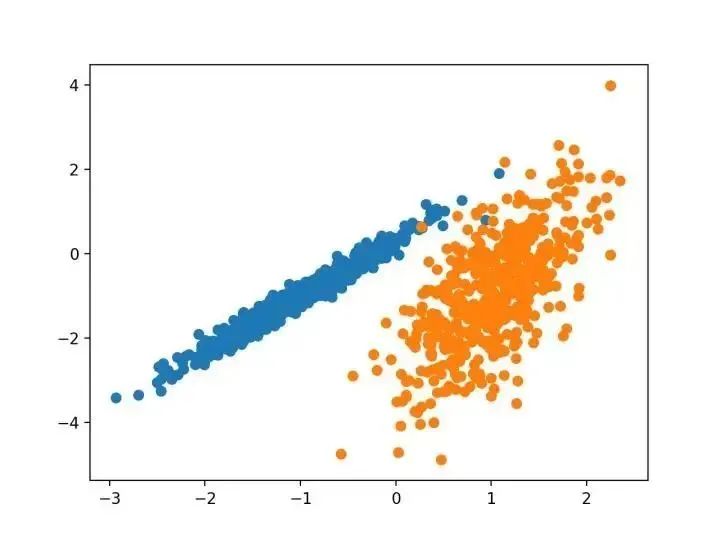
已知聚类着色点的合成聚类数据集的散点图
接下来,我们可以开始查看应用于此数据集的聚类算法的示例。我已经做了一些最小的尝试来调整每个方法到数据集。
3.亲和力传播
亲和力传播包括找到一组最能概括数据的范例。
我们设计了一种名为“亲和传播”的方法,它作为两对数据点之间相似度的输入度量。在数据点之间交换实值消息,直到一组高质量的范例和相应的群集逐渐出现 —源自:《通过在数据点之间传递消息》2007。
# 亲和力传播聚类from numpy import uniquefrom numpy import wherefrom sklearn.datasets import make_classificationfrom sklearn.cluster import AffinityPropagationfrom matplotlib import pyplot# 定义数据集X, _ = make_classification(n_samples=1000, n_features=2, n_informative=2, n_redundant=0, n_clusters_per_class=1, random_state=4)# 定义模型model = AffinityPropagation(damping=0.9)# 匹配模型model.fit(X)# 为每个示例分配一个集群yhat = model.predict(X)# 检索唯一群集clusters = unique(yhat)# 为每个群集的样本创建散点图for cluster in clusters:# 获取此群集的示例的行索引row_ix = where(yhat == cluster)# 创建这些样本的散布pyplot.scatter(X[row_ix, 0], X[row_ix, 1])# 绘制散点图pyplot.show()

# 聚合聚类from numpy import uniquefrom numpy import wherefrom sklearn.datasets import make_classificationfrom sklearn.cluster import AgglomerativeClusteringfrom matplotlib import pyplot# 定义数据集X, _ = make_classification(n_samples=1000, n_features=2, n_informative=2, n_redundant=0, n_clusters_per_class=1, random_state=4)# 定义模型model = AgglomerativeClustering(n_clusters=2)# 模型拟合与聚类预测yhat = model.fit_predict(X)# 检索唯一群集clusters = unique(yhat)# 为每个群集的样本创建散点图for cluster in clusters:# 获取此群集的示例的行索引row_ix = where(yhat == cluster)# 创建这些样本的散布pyplot.scatter(X[row_ix, 0], X[row_ix, 1])# 绘制散点图pyplot.show()
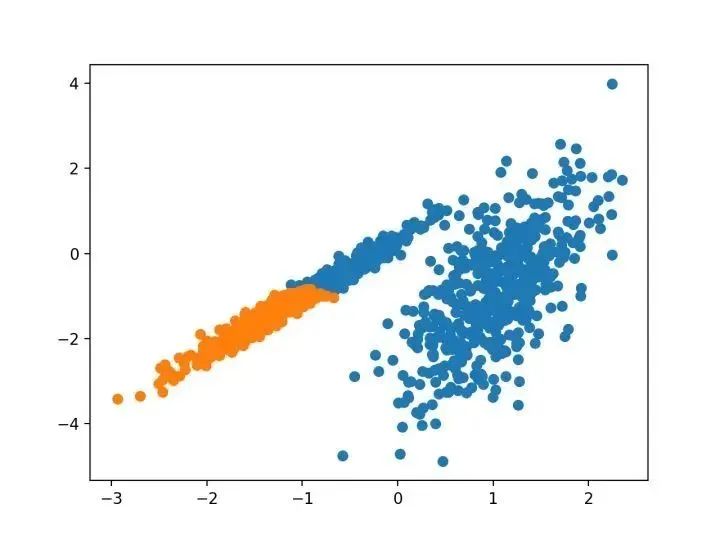
BIRCH 递增地和动态地群集传入的多维度量数据点,以尝试利用可用资源(即可用内存和时间约束)产生最佳质量的聚类。 —源自:《 BIRCH :1996年大型数据库的高效数据聚类方法》
# birch聚类from numpy import uniquefrom numpy import wherefrom sklearn.datasets import make_classificationfrom sklearn.cluster import Birchfrom matplotlib import pyplot# 定义数据集X, _ = make_classification(n_samples=1000, n_features=2, n_informative=2, n_redundant=0, n_clusters_per_class=1, random_state=4)# 定义模型model = Birch(threshold=0.01, n_clusters=2)# 适配模型model.fit(X)# 为每个示例分配一个集群yhat = model.predict(X)# 检索唯一群集clusters = unique(yhat)# 为每个群集的样本创建散点图for cluster in clusters:# 获取此群集的示例的行索引row_ix = where(yhat == cluster)# 创建这些样本的散布pyplot.scatter(X[row_ix, 0], X[row_ix, 1])# 绘制散点图pyplot.show()
 使用BIRCH聚类确定具有聚类的数据集的散点图
使用BIRCH聚类确定具有聚类的数据集的散点图
…我们提出了新的聚类算法 DBSCAN 依赖于基于密度的概念的集群设计,以发现任意形状的集群。DBSCAN 只需要一个输入参数,并支持用户为其确定适当的值 -源自:《基于密度的噪声大空间数据库聚类发现算法》,1996
# dbscan 聚类from numpy import uniquefrom numpy import wherefrom sklearn.datasets import make_classificationfrom sklearn.cluster import DBSCANfrom matplotlib import pyplot# 定义数据集X, _ = make_classification(n_samples=1000, n_features=2, n_informative=2, n_redundant=0, n_clusters_per_class=1, random_state=4)# 定义模型model = DBSCAN(eps=0.30, min_samples=9)# 模型拟合与聚类预测yhat = model.fit_predict(X)# 检索唯一群集clusters = unique(yhat)# 为每个群集的样本创建散点图for cluster in clusters:# 获取此群集的示例的行索引row_ix = where(yhat == cluster)# 创建这些样本的散布pyplot.scatter(X[row_ix, 0], X[row_ix, 1])# 绘制散点图pyplot.show()
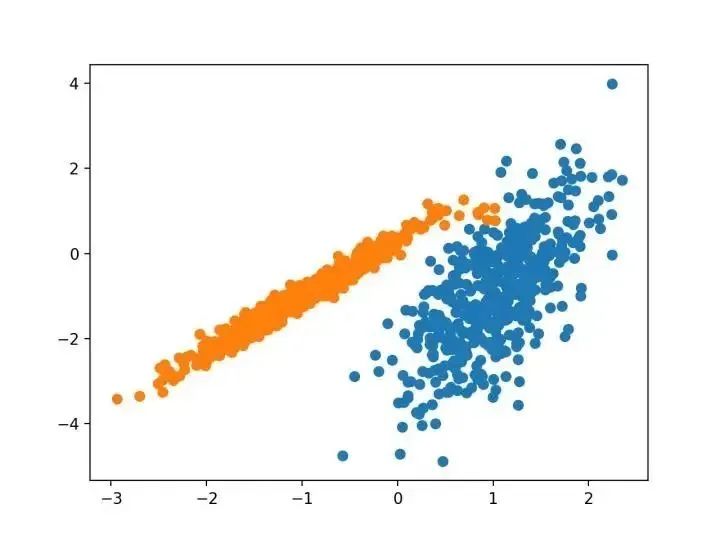
本文的主要目的是描述一种基于样本将 N 维种群划分为 k 个集合的过程。这个叫做“ K-均值”的过程似乎给出了在类内方差意义上相当有效的分区。 -源自:《关于多元观测的分类和分析的一些方法》1967年
# k-means 聚类from numpy import uniquefrom numpy import wherefrom sklearn.datasets import make_classificationfrom sklearn.cluster import KMeansfrom matplotlib import pyplot# 定义数据集X, _ = make_classification(n_samples=1000, n_features=2, n_informative=2, n_redundant=0, n_clusters_per_class=1, random_state=4)# 定义模型model = KMeans(n_clusters=2)# 模型拟合model.fit(X)# 为每个示例分配一个集群yhat = model.predict(X)# 检索唯一群集clusters = unique(yhat)# 为每个群集的样本创建散点图for cluster in clusters:# 获取此群集的示例的行索引row_ix = where(yhat == cluster)# 创建这些样本的散布pyplot.scatter(X[row_ix, 0], X[row_ix, 1])# 绘制散点图pyplot.show()

...我们建议使用 k-均值聚类的迷你批量优化。与经典批处理算法相比,这降低了计算成本的数量级,同时提供了比在线随机梯度下降更好的解决方案。 —源自:《Web-Scale K-均值聚类》2010
# mini-batch k均值聚类from numpy import uniquefrom numpy import wherefrom sklearn.datasets import make_classificationfrom sklearn.cluster import MiniBatchKMeansfrom matplotlib import pyplot# 定义数据集X, _ = make_classification(n_samples=1000, n_features=2, n_informative=2, n_redundant=0, n_clusters_per_class=1, random_state=4)# 定义模型model = MiniBatchKMeans(n_clusters=2)# 模型拟合model.fit(X)# 为每个示例分配一个集群yhat = model.predict(X)# 检索唯一群集clusters = unique(yhat)# 为每个群集的样本创建散点图for cluster in clusters:# 获取此群集的示例的行索引row_ix = where(yhat == cluster)# 创建这些样本的散布pyplot.scatter(X[row_ix, 0], X[row_ix, 1])# 绘制散点图pyplot.show()
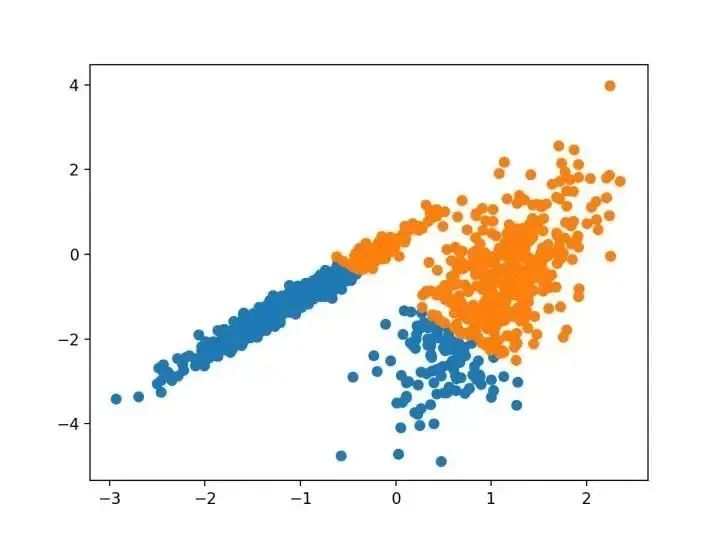
对离散数据证明了递推平均移位程序收敛到最接近驻点的基础密度函数,从而证明了它在检测密度模式中的应用。 —源自:《Mean Shift :面向特征空间分析的稳健方法》,2002
# 均值漂移聚类from numpy import uniquefrom numpy import wherefrom sklearn.datasets import make_classificationfrom sklearn.cluster import MeanShiftfrom matplotlib import pyplot# 定义数据集X, _ = make_classification(n_samples=1000, n_features=2, n_informative=2, n_redundant=0, n_clusters_per_class=1, random_state=4)# 定义模型model = MeanShift()# 模型拟合与聚类预测yhat = model.fit_predict(X)# 检索唯一群集clusters = unique(yhat)# 为每个群集的样本创建散点图for cluster in clusters:# 获取此群集的示例的行索引row_ix = where(yhat == cluster)# 创建这些样本的散布pyplot.scatter(X[row_ix, 0], X[row_ix, 1])# 绘制散点图pyplot.show()
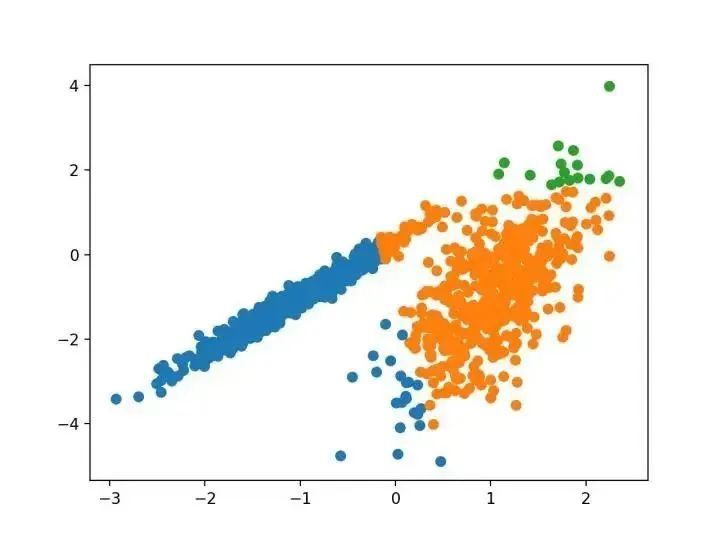
我们为聚类分析引入了一种新的算法,它不会显式地生成一个数据集的聚类;而是创建表示其基于密度的聚类结构的数据库的增强排序。此群集排序包含相当于密度聚类的信息,该信息对应于范围广泛的参数设置。 —源自:《OPTICS :排序点以标识聚类结构》,1999
# optics聚类from numpy import uniquefrom numpy import wherefrom sklearn.datasets import make_classificationfrom sklearn.cluster import OPTICSfrom matplotlib import pyplot# 定义数据集X, _ = make_classification(n_samples=1000, n_features=2, n_informative=2, n_redundant=0, n_clusters_per_class=1, random_state=4)# 定义模型model = OPTICS(eps=0.8, min_samples=10)# 模型拟合与聚类预测yhat = model.fit_predict(X)# 检索唯一群集clusters = unique(yhat)# 为每个群集的样本创建散点图for cluster in clusters:# 获取此群集的示例的行索引row_ix = where(yhat == cluster)# 创建这些样本的散布pyplot.scatter(X[row_ix, 0], X[row_ix, 1])# 绘制散点图pyplot.show()

最近在许多领域出现的一个有希望的替代方案是使用聚类的光谱方法。这里,使用从点之间的距离导出的矩阵的顶部特征向量。 —源自:《关于光谱聚类:分析和算法》,2002年
# spectral clusteringfrom numpy import uniquefrom numpy import wherefrom sklearn.datasets import make_classificationfrom sklearn.cluster import SpectralClusteringfrom matplotlib import pyplot# 定义数据集X, _ = make_classification(n_samples=1000, n_features=2, n_informative=2, n_redundant=0, n_clusters_per_class=1, random_state=4)# 定义模型model = SpectralClustering(n_clusters=2)# 模型拟合与聚类预测yhat = model.fit_predict(X)# 检索唯一群集clusters = unique(yhat)# 为每个群集的样本创建散点图for cluster in clusters:# 获取此群集的示例的行索引row_ix = where(yhat == cluster)# 创建这些样本的散布pyplot.scatter(X[row_ix, 0], X[row_ix, 1])# 绘制散点图pyplot.show()

# 高斯混合模型from numpy import uniquefrom numpy import wherefrom sklearn.datasets import make_classificationfrom sklearn.mixture import GaussianMixturefrom matplotlib import pyplot# 定义数据集X, _ = make_classification(n_samples=1000, n_features=2, n_informative=2, n_redundant=0, n_clusters_per_class=1, random_state=4)# 定义模型model = GaussianMixture(n_components=2)# 模型拟合model.fit(X)# 为每个示例分配一个集群yhat = model.predict(X)# 检索唯一群集clusters = unique(yhat)# 为每个群集的样本创建散点图for cluster in clusters:# 获取此群集的示例的行索引row_ix = where(yhat == cluster)# 创建这些样本的散布pyplot.scatter(X[row_ix, 0], X[row_ix, 1])# 绘制散点图pyplot.show()

三. 总结
聚类是在特征空间输入数据中发现自然组的无监督问题。 有许多不同的聚类算法,对于所有数据集没有单一的最佳方法。 在 scikit-learn 机器学习库的 Python 中如何实现、适合和使用顶级聚类算法。
评论
